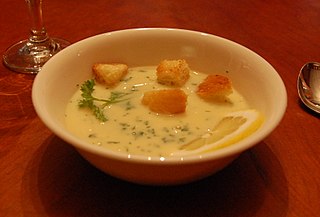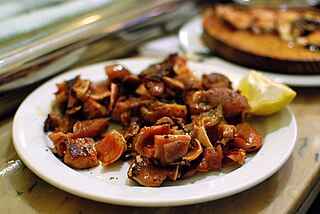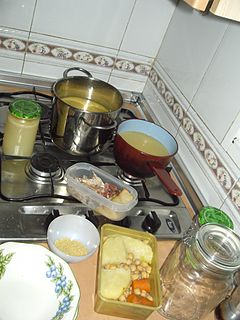
Spanish cuisine consists of the cooking traditions and practices from Spain. Olive oil is heavily used in Spanish cuisine. It forms the base of many vegetable sauces. Herbs most commonly used include parsley, oregano, rosemary and thyme. The use of garlic has been noted as "common to all Spanish cooking." The most used meats in Spanish cuisine include chicken, pork, lamb and veal. Fish and seafood are also consumed on a regular basis.

Feijoada is a stew of beans with beef and pork. The name feijoada comes from feijão, 'bean' in Portuguese. It is widely prepared in the Portuguese-speaking world, with slight variations.

Avgolemono or egg–lemon is a family of sauces and soups made with egg yolk and lemon juice mixed with broth, heated until they thicken. They are found in Greek, Arab, Sephardic Jewish, Turkish, Balkan and Jewish-Italian cuisine.

A perpetual stew, also known as forever soup, hunter's pot or hunter's stew, is a pot into which whatever one can find is placed and cooked. The pot is never or rarely emptied all the way, and ingredients and liquid are replenished as necessary. The concept is often a common element in descriptions of medieval inns. Foods prepared in a perpetual stew have been described as being flavorful due to the manner in which the ingredients blend together, in which the flavor may improve with age.

Sancocho is a traditional broth in several Latin American cuisines. Variations represent popular national dishes in Puerto Rico, Honduras, Ecuador, Colombia, Cuba, Panama, Dominican Republic, Trinidad and Tobago, and Venezuela. It usually consists of large pieces of meat, tubers and vegetables served in a broth.

Pot-au-feu is a French beef stew. According to the chef Raymond Blanc, pot-au-feu is "the quintessence of French family cuisine; it is the most celebrated dish in France and considered a national dish. It honours the tables of the rich and poor alike."

Castilian-Leonese cuisine refers to the typical dishes and ingredients of the region of Castile and León in Spain. This cuisine is known for its cooked dishes (guiso) and its grilled or roasted meats (asado), its high-quality wines, the variety of its desserts, its sausages (embutidos), and its cheeses.
Canarian cuisine refers to the typical dishes and ingredients in the cuisine of the Canary Islands, and it constitutes an important element in the culture of its inhabitants. Its main features are its freshness, variety, simplicity, and the richness of its ingredients, the mix of seafood and meat dishes, its cultural influences and the low knowledge of it by the rest of the world. Canarian cuisine is influenced by other cultures, specially the aboriginal inhabitants of the islands (Guanches) and Latin American cuisine.

Olla podrida is a Spanish stew, usually made with chickpeas or beans, and assorted meats like pork, beef, bacon, partridge, chicken, ham, sausage, and vegetables such as carrots, leeks, cabbage, potatoes and onions.

Cazuela is the common name given to a variety of dishes, especially from South America. It receives its name from the cazuela - traditionally, often shallow and of unglazed earthenware - in which it is cooked. The ingredients and preparation vary from region to region, but it is usually a mid-thick flavoured stock obtained from cooking several kinds of meats and vegetables mixed together.

Pig's ear, as food for human consumption, is the cooked ear of pig. It is found in a number of cuisines around the world.

Most traditional foods in Guatemalan cuisine are based on Maya cuisine, with Spanish influence, and prominently feature corn, chilies and beans as key ingredients. Guatemala is famously home to the Hass avocado and the birthplace of chocolate, as first created by the Maya.

Cocido or cozido is a traditional stew eaten as a main dish in Spain, Portugal, Brazil and other Hispanophone and Lusophone countries.

Extremadura, Spain is known for its different ways of preparing the Iberian pork and mutton. The main characteristics of the traditional Extremaduran cuisine were its simplicity, its lack of clutter and its low cost. It is also a cuisine reflecting a generous spirit, for many of its preparations used to be cooked in large pots to share with visitors, friends, and neighbors. The resulting dishes are eaten with local bread.

Puchero is a type of stew originally from Spain, prepared in Yucatán, Mexico, Argentina, Paraguay, Uruguay, Perú, south of Brazil, the Philippines, and Spain, specifically the autonomous communities of Andalusia and the Canary Islands. The Spanish word "puchero" originally meant an earthenware pot, before being extended to mean any vessel, and then the dish cooked in it.

Cocido montañés is a rich hearty Spanish bean stew, originally from and most commonly found in Cantabria in northern Spain.

Run down, also referred to as rundown, run dun, rondón, fling-me-far, and fling mi for, is a stew dish in Jamaican cuisine and Tobago cuisine. The traditional Jamaican dish is eaten in several Latin American countries that share a coast with the Caribbean Sea.

A stew is a combination of solid food ingredients that have been cooked in liquid and served in the resultant gravy. Ingredients in a stew can include any combination of vegetables and may include meat, especially tougher meats suitable for slow-cooking, such as beef, pork, lamb, poultry, sausages, and seafood. While water can be used as the stew-cooking liquid, stock is also common. A small amount of red wine is sometimes added for flavour. Seasoning and flavourings may also be added. Stews are typically cooked at a relatively low temperature, allowing flavours to mingle.

Callos a la Madrileña is a stewed tripe dish, cooked slowly for hours over low heat, that is a speciality of Spanish cuisine associated with the city of Madrid. Traditionally pig or cow tripe was used but modern recipes use lamb or even cod. It includes pig snout and trotters, black pudding, sausage, ham, and soup vegetables like carrots and onions. When prepared correctly the broth is rich in gelatin and the tripe becomes very tender after the slow cooking process. The tripe can be browned before the cooking liquid is added, with trotter's, oxtails and other ingredients for the soup like ham, chorizo and smoked paprika. It is common to serve this stew with the morcilla blood sausage, a tapas dish typical of the region of Castile and León.





















